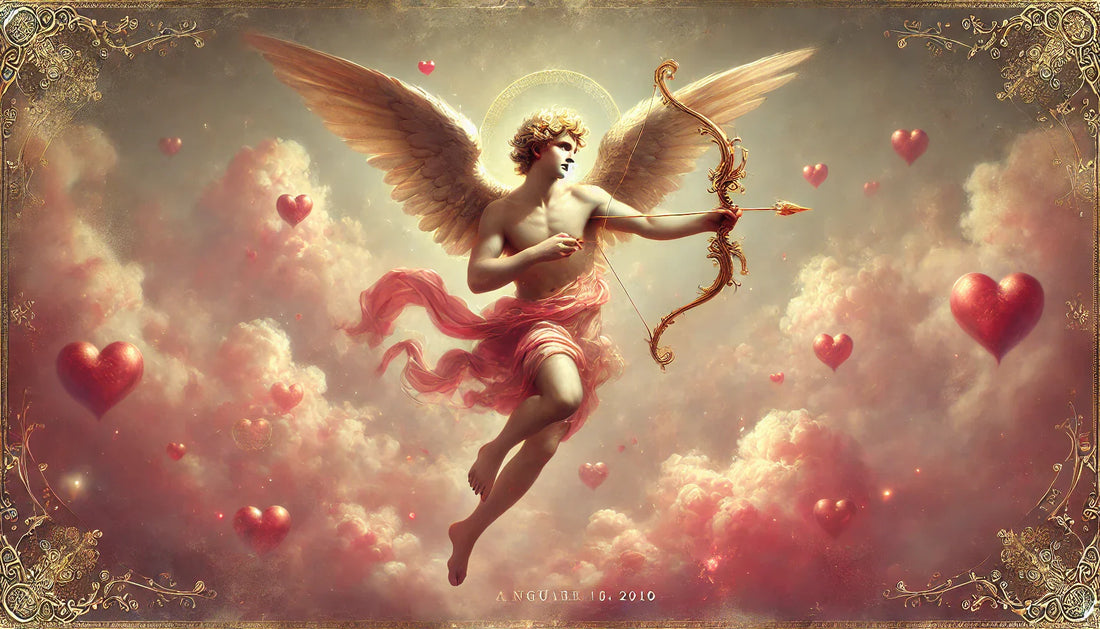
Cupid: God of Love and Desire
Cody ManesShare
A Divine Symbol of Passion and Romance
Few mythological figures are as deeply intertwined with the concept of love as Cupid. Known as the Roman god of desire, affection, and attraction, Cupid has captivated humanity for centuries. His presence is felt in literature, art, and modern Valentine’s Day traditions, making him one of the most enduring deities associated with romance. But Cupid is more than just a playful cherub with a bow—his origins, mythology, and influence reveal a complex and powerful divine being who has shaped how love is understood and celebrated throughout history.
The Origins of Cupid: From Primordial Chaos to Love’s Messenger
Cupid’s origins trace back to Roman mythology, where he was often considered the son of Venus, the goddess of love and beauty, and Mars, the god of war. However, earlier versions of Eros in Greek mythology depicted him as a primordial force that existed before the Olympian gods. This duality—love and conflict—made Cupid a unique figure, embodying both the sweetness and turmoil of passion. However, his lineage has variations, with some accounts linking him to primordial deities like Nyx, also known as Night, or Chaos itself, tying love to the very fabric of creation. His association with Venus highlights his role as a facilitator of love, whereas his connection to Mars demonstrates the undeniable link between love and conflict, showing that passion can be both a source of joy and a harbinger of strife.
Cupid’s Greek counterpart, Eros, appears in Greek mythology as a primordial force of attraction that helped bring order to the cosmos. The earliest representations of Eros depicted him not as a winged boy, but as a powerful and sometimes even fearsome entity that predated the gods themselves. Later interpretations of Eros softened his image, portraying him as a youthful, mischievous archer responsible for inspiring love and desire. Over time, these attributes merged into the Roman Cupid, who retained both his mischievous nature and divine significance. His role in mythology evolved from a primeval being of creation to a guiding force in human and divine relationships alike.
The Iconic Bow and Arrows: Weapons of the Heart
One of the most recognizable symbols of Cupid is his bow and arrows, which were said to hold the power to ignite love or indifference. According to legend, Cupid carried two types of arrows. Golden arrows, imbued with the essence of desire, caused the struck individual to fall hopelessly in love. Lead arrows, on the other hand, had the opposite effect, creating aversion and disdain, repelling even the deepest affections. This duality of Cupid’s arrows reflected the unpredictable nature of love—joyful yet painful, desired yet feared. He was not merely a bringer of romance but also an agent of chaos, capable of intertwining fate in unexpected ways. His bow and arrows granted him a level of power that transcended even the influence of other deities, as love and rejection are forces that can dictate the rise and fall of empires, shape the fates of heroes, and alter the course of history.
Throughout classical mythology, Cupid’s interventions with his arrows resulted in some of the most famous and tragic love stories. The love he inspired was often uncontrollable and overwhelming, a force that neither mortals nor gods could resist. He played a pivotal role in the relationships of deities and mortals alike, ensuring that love, whether blissful or tragic, remained an essential component of mythological narratives.
Cupid and Psyche: A Tale of Love, Betrayal, and Immortality
One of the most famous myths surrounding Cupid is his love story with Psyche, a mortal woman whose beauty rivaled that of Venus. This myth is one of the earliest fairy-tale-like romances, exploring themes of trust, devotion, and transformation. Psyche was so beautiful that people worshiped her instead of Venus, angering the goddess. In retaliation, Venus ordered Cupid to make Psyche fall in love with a hideous monster. However, upon seeing Psyche, Cupid himself fell deeply in love and disobeyed his mother’s command. Instead of striking her with a lead arrow, he secretly took her as his own, visiting her in secrecy each night but never allowing her to see his face.
Psyche, driven by curiosity and the manipulations of her jealous sisters, attempted to reveal Cupid’s true identity by using a lamp while he slept. The moment the light fell upon his face, Cupid awoke and fled, heartbroken by her lack of trust. Determined to prove her love, Psyche endured a series of harsh trials set by Venus, including descending into the Underworld. Through perseverance and divine intervention, she was eventually reunited with Cupid and granted immortality by Jupiter, the Roman equivalent of Zeus, allowing their love to endure eternally. The myth of Cupid and Psyche highlights love’s ability to overcome obstacles, illustrating the importance of trust, sacrifice, and the transformative power of true devotion. Their love story remains one of mythology’s most enduring tales, emphasizing that love requires resilience, courage, and unwavering faith.
Cupid’s Influence on Valentine’s Day and Romantic Traditions
Cupid’s image as a cherubic, winged archer became synonymous with Valentine’s Day, a holiday dedicated to celebrating love. The tradition of associating Cupid with romance dates back to medieval and Renaissance literature, where he was depicted in poetry and art as a mischievous yet noble force guiding lovers toward their destinies. During the Middle Ages, love was often viewed through the lens of courtly romance, with Cupid serving as an agent of divine matchmaking. His role in Renaissance art further solidified his presence as the ultimate symbol of love and passion. His image was found in grand frescoes, decorative tapestries, and paintings where he appeared with his bow drawn, poised to strike lovers with the power of passion and devotion.
Cupid’s association with love became more prominent during the Renaissance, and by the Victorian era, he had become a staple of Valentine’s Day imagery, frequently appearing in greeting cards and artwork celebrating romance. His presence in greeting cards, love letters, and artwork cemented his role as the bringer of romance. The commercialization of love further expanded Cupid’s influence, making him one of the most widely recognized figures in celebrations of romance. Today, he is a universal symbol of love, appearing in everything from advertisements to wedding décor, reinforcing the idea that love strikes unexpectedly and irresistibly. Even in the digital age, the influence of Cupid persists, with his image appearing in online matchmaking services, romantic films, and social media, where the concept of love continues to be celebrated in ways both traditional and modern.
Embracing the Spirit of Cupid Today
Cupid’s legend endures because love remains one of the most powerful and universal human experiences. Whether we view him as a playful matchmaker or a divine force guiding soulmates together, his myth continues to inspire those who believe in the power of romance. His story reminds us that love, in all its forms, is an adventure—one that requires faith, perseverance, and, sometimes, a little divine intervention. So, the next time you see an image of Cupid with his bow and arrows, remember that he represents more than just fleeting infatuation—he is the eternal spirit of love’s joys, trials, and triumphs. His presence in mythology and modern culture serves as a testament to the timeless nature of love, proving that passion, devotion, and romance are as vital today as they were in the age of the gods.
Ready for more? Dive into our next topic: Papa Legba
